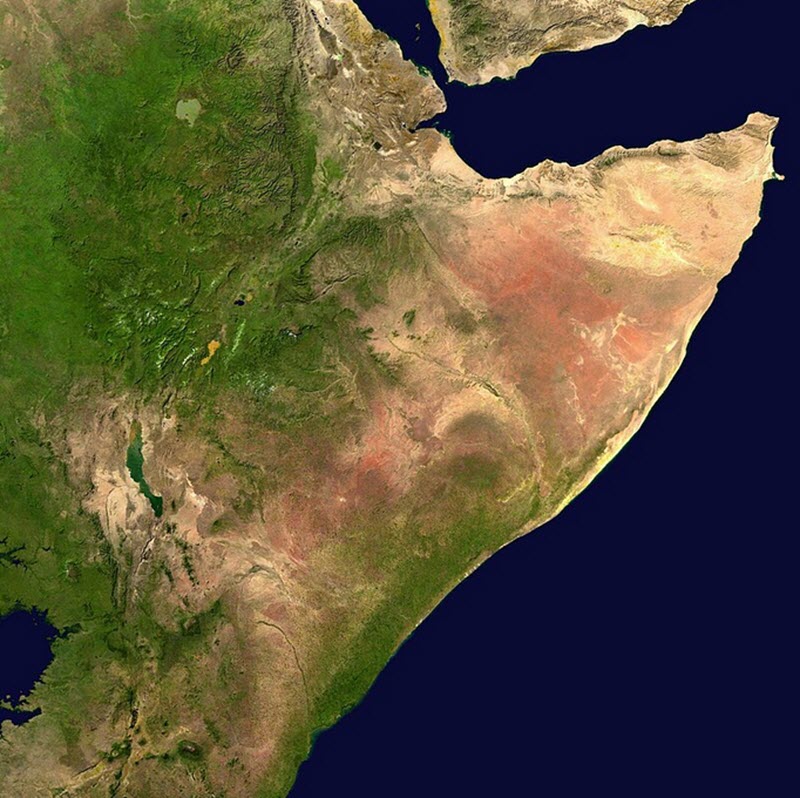Contents
The Horn of Africa, a peninsula in Northeast Africa, juts hundreds of kilometers into the Arabian Sea and lies along the southern side of the Gulf of Aden. The region is named for its horn-like shape and encompasses Djibouti, Eritrea, Ethiopia, and Somalia.
With its strategic location by the Bab-el-Mandeb Strait, the Horn of Africa holds significant geopolitical and economic importance. The Bab-el-Mandeb Strait is a gateway to the Suez Canal, one of the world’s most crucial maritime routes.
This overview explores the region’s geographical features, cultural diversity, historical significance, and contemporary challenges.

Geographical and environmental overview
The Horn of Africa is characterized by a variety of landscapes, including deserts, mountains, and plateaus. It is home to the Ethiopian Highlands, one of the major mountain ranges in Africa, which includes the Simien Mountains National Park, a UNESCO World Heritage site. The region’s climate varies from arid in the coastal areas to more temperate in the highlands. Environmental challenges such as droughts and desertification significantly impact the livelihoods of its inhabitants.
Cultural and linguistic diversity
The Horn of Africa is a melting pot of cultures, languages, and religions. It hosts a myriad of ethnic groups, including the Somali, Amhara, Oromo, and Tigrayans, among others. The region’s linguistic diversity is reflected in the Afroasiatic language family, which includes Somali, Amharic, Oromo, and Tigrinya. Islam and Christianity are the predominant religions, with a rich history that dates back to the early centuries of the respective faiths.
Examples of major population centres in the region
Mogadishu in Somalia
Somalia has an estimated population exceeding 17 million people, and over 2 million of them live in Mogadishu, which is Somalia´s capital and most populated city.
Addis Abada in Ethiopia
Between 1983 and 2018, the population of Ethiopia grew from slightly more than 38 million people to nearly 110 million people. Addis Abada, which is the capital and most populated city in the country, is home to approximately 3.9 million people (estimated for 2023).
Asmara in Eritrea
Sources disagree widely regarding the current population size of Eritrea, with some sources proposing numbers as high as 6.7 million and others as low as 3.6 million. The Eritrean government has never conducted any census. The capital and most populous city of Eritrea is Asmara, which is believed to have a population of roughly 1 million people (2023 estimate).
Djibouti City in Djibouti
Djibouti is the smallest and least populated of the four countries, with an estimated population of less than 977,000 in 2023. A very large percentage of the total population lives in Djibouti City or close to the city, as the country as a whole only encompasses 23,200 square kilometres (8,958 sq mi). Roughly 600,000 people are estimated to live in Djibouti City.
History
The Horn of Africa has a multifaceted history that includes, among other things, ancient kingdoms, trade with the Middle East and Asia, and European colonization. The region’s strategic location made it a focal point for trade routes connecting the Middle East, Asia, and Africa, influencing the cultural and economic development of the area.
The Aksumite Empire, which emerged in present-day Eritrea and northern Ethiopia, was one of the ancient world’s great civilisations, known for its monumental obelisks and as an early adopter of Christianity.
At its peak, the Aksumite Empire was still based in what is now northern Ethiopia and Eritrea, but also encompassed present day Djibouti and Sudan, and extended into much of southern Arabia. It greatly influenced the Horn of Africa – even the areas that were not considered a part of the empire.
The Aksumite Empire, known as the Kingdom of Axum, existed from Classical antiquity to the Middle Ages. It was founded around 150 BC, emerging from the earlier Dʿmt kingdom. Axum, a town in the Tigray Region of Ethiopia, was the empire’s capital for many centuries, but in the 9th century AD, declining trade connections and recurring invasions prompted a move to Kubar.
There were strong connections between the Axum Empire and the Greco-Roman cultural sphere, and Greek eventually became a commonly used language in addition to the official language, Ge´ez. Greek was especially common in trade, diplomacy and administration, partly due to a growing influence from Ethiopian Greek communities in Axum, Adulis, and Ptolemais Theron during Ptolematic times.
Contemporary challenges and opportunities
Today, the Horn of Africa faces a range of challenges, including political instability, conflict, poverty, and environmental issues. The region has experienced significant political changes, including Ethiopia’s recent reforms under Prime Minister Abiy Ahmed and the peace agreement between Ethiopia and Eritrea. However, conflicts such as the ongoing situation in Somalia and tensions in Ethiopia’s Tigray region highlight the area’s complex security issues.
Despite these challenges, the Horn of Africa has significant economic potential, particularly in sectors like agriculture, energy, and logistics. The region’s ports, such as Djibouti’s Port of Doraleh, are vital for international trade and have attracted significant foreign investment.
Conclusion
The Horn of Africa is strategically significant, marked by its rich cultural heritage, historical depth, and diverse landscapes. While it faces considerable challenges, its strategic location and economic potential offer opportunities for development and regional cooperation. Addressing the Horn of Africa’s contemporary issues requires a nuanced understanding of its complex historical, cultural, and geopolitical landscape.